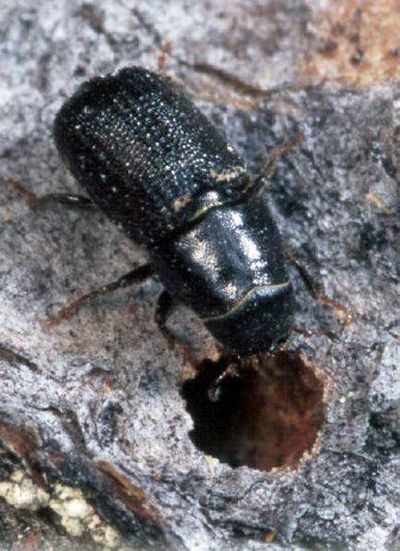B.C. beetle infestations take bite of timber supply

Tiny beetles chewing through British Columbia’s forest are creating big worries for the Inland Northwest timber industry.
The province is now attempting to slow the spreading plague of mountain pine beetles by cutting as much infested forest as possible. An area of forest half the size of Washington – some 21 million acres – is already infested in what provincial officials say is the worst natural disaster to ever befall British Columbia.
With so much timber slated to be cut, Inland Northwest sawmill owners say they fear a coming market flood.
“They’re going to bury us in the sand,” said Dick Bennett, owner of Bennett Forest Industries in Grangeville, Idaho.
With interest rates creeping up, demand for timber for new housing is also expected to cool, Bennett said. Nonetheless, Bennett recently moved his sawmill closer to available timber supply and has invested in new equipment. “If you’re not strong, you’re out of business,” he said.
Mountain pine beetles are native to British Columbia and the Inland Northwest, but increasingly warm winter temperatures and an abundance of lodgepole pine host trees have helped the insects flourish, according to a 2005 report on the epidemic from the University of British Columbia’s Forest Resources Management Department. “The warming trend in the interior has produced ideal conditions for the mountain pine beetle,” the report says.
The largest previous outbreak peaked in the 1930s with about 1.2 million acres killed. The current epidemic is nearly 20 times larger and threatens to spill across massive amounts of boreal forest east of the Canadian Rockies. The province is now facing the worst-case scenario and is trying to slow the infestation by recently boosting allowable timber cuts by 78 percent.
The move has attracted a flood of investment in boosting cutting and sawmill capacity in British Columbia. C.H. Anderson and Partners announced a plan in October to invest $110 million in four wood pellet plants in the province to supply fuel for power plants in Europe. A statement issued by the company said the work will support 640 new jobs. The following month, Ainsworth Lumber Co. announced it would add about 750 new jobs and spend $400 million, Canadian, on a new oriented-strand-board plant in British Columbia.
Duane Vaagen, owner of a sawmill in Colville, said his business has explored ways to tap into B.C.’s timber boom, but restrictive trade policies and expensive cross-border rail shipping rates make it nearly impossible. Vaagen described the climate in British Columbia timber towns as a “gold rush.” Mills are running three shifts, and some are buying equipment from closed sawmills in the United States.
Vaagen said he expects to begin feeling the impact of all the timber shortly.
“We’re within a year of getting bit,” he said.
Both Vaagen and Bennett stressed they don’t blame British Columbia for cutting the infested trees. “That’s the prudent thing to do,” Vaagen said.
John McLean, a forest entomologist at the University of British Columbia, said the province has little choice but to try and salvage some value from the forests. But McLean said the situation is not like a gold rush.
“Gold sits in the ground waiting for you to find it no matter how long it takes,” McLean said. “In this case we have dead timber that is degrading as it sits on the stump. A big effort is under way to access as much as can be handled by the system while at the same time plant trees on the cut-over lands to ensure that the new crop is established.”
The epidemic is expected to last an additional 10 years or until at least 80 percent of the province’s lodgepole pine forests are eaten by the beetles. This summer alone, 90 million cubic meters of timber is expected to be killed by beetles, according to estimates from the province. As a comparison, the province’s annual timber harvest during the 1990s averaged about 75 million cubic meters.
The southern border of the main outbreak is near Kamloops, B.C., about 250 miles north of Spokane. But there are smaller outbreaks closer to the border. There are also several smaller infestations of mountain pine beetle in the Inland Northwest, including in higher elevation forest in the Lookout Pass area on the Montana-Idaho border and in the Bitterroot Mountains between Idaho’s St. Joe River and St. Regis, Mont., according to Tom Martin, silviculturist for the Idaho Panhandle National Forests.
“Fortunately for forest health we don’t have a whole lot of lodgepole pine,” Martin said.
The Lookout Pass and Bitterroot Mountain area outbreaks have likely peaked in intensity, Martin said, but forest in the Upper St. Joe watershed and near Bonners Ferry will see an increased risk in coming years for infestation.
It takes two or three weeks of bitter cold weather, with sustained temperatures of minus-20 or lower, to kill off beetle larvae. December’s cold snap likely was not cold enough, Martin said.
“I doubt we had any significant impact on it,” he said.